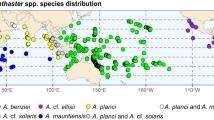Abstract
A karyological and morphological analysis of 97 specimens from eastern Australia belonging to the Gyratrix hermaphroditus species complex was performed. Based on karyotype and on details of sclerotized structures of the copulatory organ, the existence of at least eight sibling species in eastern Australia could be recognised. Some of the siblings have a wide distribution across eastern and northern Australia. Populations of wide-ranging species often showed degrees of karyological and morphological differentiation. The diversity of the group is particularly high in tropical Australia. Distribution of siblings appears to be affected by ecological and physical barriers, and determined by sediment texture.
Similar content being viewed by others
References
Armonies, W., 1988. Physical factors influencing active emergence of meiofauna from boreal intertidal sediments. Mar. Ecol. Progr. Ser. 49: 277–286.
Benazzi, M., 1982. Speciation events evidenced in Turbellaria. In Barigozzi, C. (ed.), Mechanisms of Speciation. Alan R. Liss, New York: 307–344.
Birstein, V.J., 1991. On the karyotypes of the Neorhabdocoela species and karyological evolution of Turbellaria. Genetica 83: 107–120.
Clarke, K. R. & R. H. Green, 1988. Statistical design and analysis for a ‘biological effects’ study. Mar. Ecol. Progr. Ser. 46: 213–226.
Curini-Galletti, M. C. & I. Puccinelli, 1989. Karyometric and morphological analysis of two sympatric marine species of the Gyratrix hermaphroditus complex (Platyhelminthes: Kalyptorhynchia) occurring at Roscoff (Brittany, France). Hydrobiologia 173: 63–68.
Curini-Galletti, M. C. & I. Puccinelli, 1990. The Gyratrix hermaphroditus Specie Complex (Platyhelminthes: Kalyptorhynchia) in the Darwin Area (Northern Territory, Australia). Trans. am. Microsc. Soc. 109: 368–379.
Curini-Galletti, M. C. & I. Puccinelli, 1994. The Gyratrix hermaphroditus Specie-Complex (Platyhelminthes Kalyptorhynchia) in marine tropical areas: first data from the Caribbean. Belg. J. Zool. 124: 157–166.
Heitkamp, U., 1978. Speciationsprozesse bei Gyratrix hermaphroditus Ehrenberg, 1831 (Turbellaria, Kalyptorhynchia). Zoomorphologie 90: 227–251.
Knowlton, N., 1993. Sibling Species in the Sea. Ann. Rev. ecol. System 24: 189–216.
Levan, A., K. Fredga, & A. A. Sandberg, 1964. Nomenclature for centromeric position on chromosomes. Hereditas 52: 201–220.
L'Hardy, J. P., 1986. Karyology of marine populations of Gyratrix hermaphroditus (Turbellaria: Rhabdocoela) and chromosomal evolution in this species complex. Hydrobiologia 132: 233–238.
Mallet, J., 1995. A species definition for the Modern Synthesis. Trends Ecol. Evol. 10: 294–299.
Martens, P. M., 1984. Comparison of three different extraction methods for Turbellaria. Mar. Ecol. Progr. Ser., 14: 229–234.
Mayr, E., 1982. The Growth of Biological Thought: Diversity, Evolution and Inheritance. Harvard Univ. Press, Cambridge, Mass: 974 pp.
Palmer, A. A., 1988. Dispersal of marine meiofauna: a review and conceptual model explaining passive transport and active emergence with implications for recruitment. Mar. Ecol. Progr. Ser. 48: 81–91.
Puccinelli, I. & M. C. Curini-Galletti, 1987. Chromosomal evolution and speciation in marine populations of Gyratrix hermaphroditus sensu lato (Platyhelminthes: Kalyptorhynchia) and in other species of the Gyratricinae. Trans. am. Microsc. Soc. 106: 311–320.
Puccinelli, I., M. C. Curini-Galletti, G. Mariotti & I. Moretti, 1990. Chromosomal evolution and speciation in the Gyratrix hermaphroditus species complex (Platyhelminthes, Kalyptorhynchia): karyometric and morphological analyses of fifteen fresh-water populations from Western Europe. Hydrobiologia 190: 83–92.
Reuter, M., 1961. Untersuchungen uber Rassenbildung bei Gyratrix hermaphroditus (Turbellaria Neorhabdocoela). Acta biol. fenn. 100: 1–32.
Rohlf, F. J., 1990. NTSYS-pc. Numerical Taxonomy and Multivariate Analysis System. Version 1.60. Exeter Software, NY, Copyright 1990 by Applied Biostatistics Inc., NY.
Author information
Authors and Affiliations
Rights and permissions
About this article
Cite this article
Curini-Galletti, M., Puccinelli, I. The Gyratrix hermaphroditus species complex (Kalyptorhynchia: Polycystididae) in marine habitats of eastern Australia. Hydrobiologia 383, 287–298 (1998). https://doi.org/10.1023/A:1003456102035
Issue Date:
DOI: https://doi.org/10.1023/A:1003456102035




